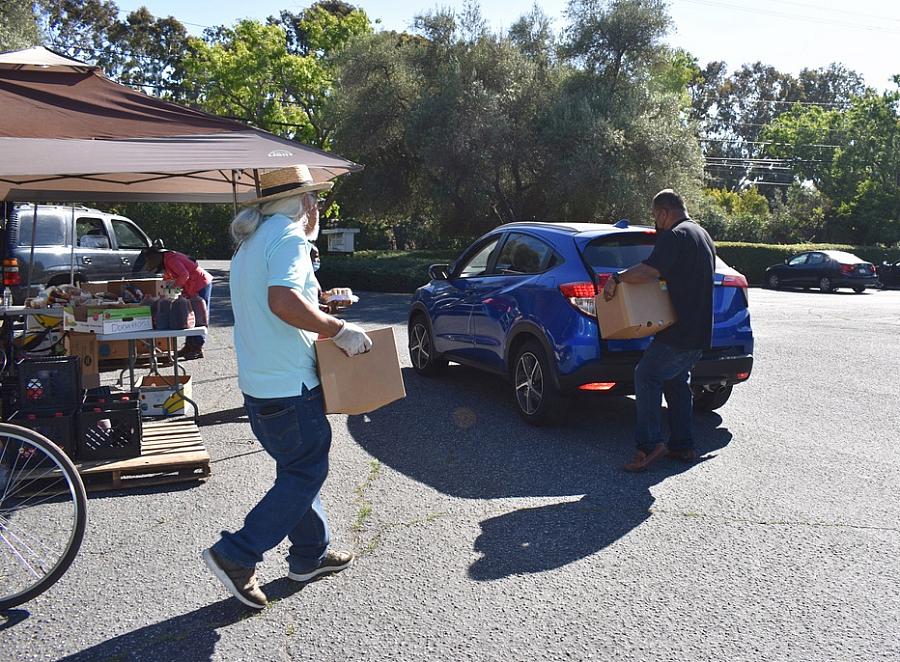When the data isn’t there, on-the-ground reporting helps fill in the gaps

Volunteers load boxes of food into vehicles at a food distribution site in Palo Alto.
(Photo by Kate Bradshaw)
Throughout my data reporting fellowship, one of the big challenges I ran into was the lack of data about the topic I had hoped to explore: evictions during the pandemic.
My initial proposal centered on what at the time looked to be the devastating end of California’s eviction moratorium, in February 2021. However, the end date for that program was pushed back, first to the end of June and then September. These extensions were positive for struggling tenants but made completing my proposed project much harder.
After running into several dead ends, and with the support of my fellowship advisors, I pivoted to another topic that interested me deeply: food security during the pandemic.
The switch led me to learn more about the major shift that the pandemic had triggered for local food support systems.
An advisor connected me with a team of Stanford students and graduates called unBox, who had built a database of school meals throughout the Bay Area.
Their database compiled information from school districts about when and how to access school meals that were being distributed while students attended school remotely.
I learned that districts took widely varied approaches to get meals to families in need. Some were more successful than others.
From there, I worked with unBox and Second Harvest of Silicon Valley, the local food bank, to access data from the California Department of Education on how many meals each school district in San Mateo and Santa Clara counties had distributed over two months in the 2021-22 school year, versus 2020-21. I was able to identify which districts had been relatively successful compared to the prior year. I spoke with their child nutrition leaders to learn what approaches they'd taken and what lessons they'd learned.
I think taking a “lessons learned” approach in my interviews added to the story because it kept the focus on policies rather than individuals. The tone of the interviews was positive, as these nutrition providers had a chance to talk about their successes as well as obstacles they faced in the Herculean task of setting up new systems for safely feeding hungry kids through a pandemic.
For the second piece in the series, I reported on the USDA's Farmers to Families Food Box program and its impacts locally. On the positive side, several of the early contract rounds of the program enabled a local food aid nonprofit, Fresh Approach, to develop a network of local farms that distributed their surplus high-quality produce to hungry families. This created connections that lasted even after the contracts ended.
On the negative side, later contract rounds with these local farms were canceled and appeared to lack accountability for safely distributing food boxes containing perishable goods. The program ended at the end of May 2021.
With the second story, I again faced the obstacle of lack of data. I did not have enough time before the project's deadline to realistically expect a federal records request to come through, and I couldn't persuade one of the program leaders to share some of the data with me. Ultimately, with the guidance of my advisor, I moved forward with the story without the data I wanted because it was timely and newsworthy, and we felt it needed to be broken sooner rather than later.
Fortunately, I was able to supplement my reporting with academic research from a local professor, Christopher Bacon of Santa Clara University, and a report by the Harvard Law School’s Food Law and Policy Clinic and the National Sustainable Agriculture Coalition.
After more than a year of trying to do as much reporting remotely as possible, this project also reminded me that going to the scene and doing on-the-ground reporting provides information and context reporters cannot get any other way.
For example, as I investigated the apparent lack of accountability in the distribution of the USDA farm boxes, I heard from one of my interviews that large boxes of food containing perishable items such as frozen meats and dairy — products requiring refrigeration — were being left on street corners in the nearby community of East Palo Alto.
It took a bit of lurking on the only place where the community was alerted about these food boxes, the East Palo Alto Neighbors Facebook group, to identify a pattern of when and where the food boxes were left. Knowing they were generally delivered on Friday afternoons, I watched the Facebook group for the weekly alert. Sure enough, I arrived and the boxes were just sitting on the street. People came by and loaded up their vehicles with as many boxes as they wanted.
I interviewed people at the site and learned that most didn't know where the food had come from or how long it had been left there. It was a sad testament to the fact that food aid was desperately needed yet lacking in basic safety precautions.
For the third piece in the series, I took a big-picture look at policies and initiatives coming out of the pandemic. To me, one of the most interesting questions was how local farms and agricultural producers are adapting to what's called a "multi-hazard" environment.
For instance, one of the nonprofit farms I interviewed, Pie Ranch, was hit not only by the pandemic, which caused it to have to rethink its youth education focus, but also with the impacts of the devastating CZU August Lightning Complex wildfire in the Santa Cruz Mountains in August 2020. Trying to understand how food producers are affected not just by COVID-19 but also the ever-growing reality of climate change added to the urgency of the story.

